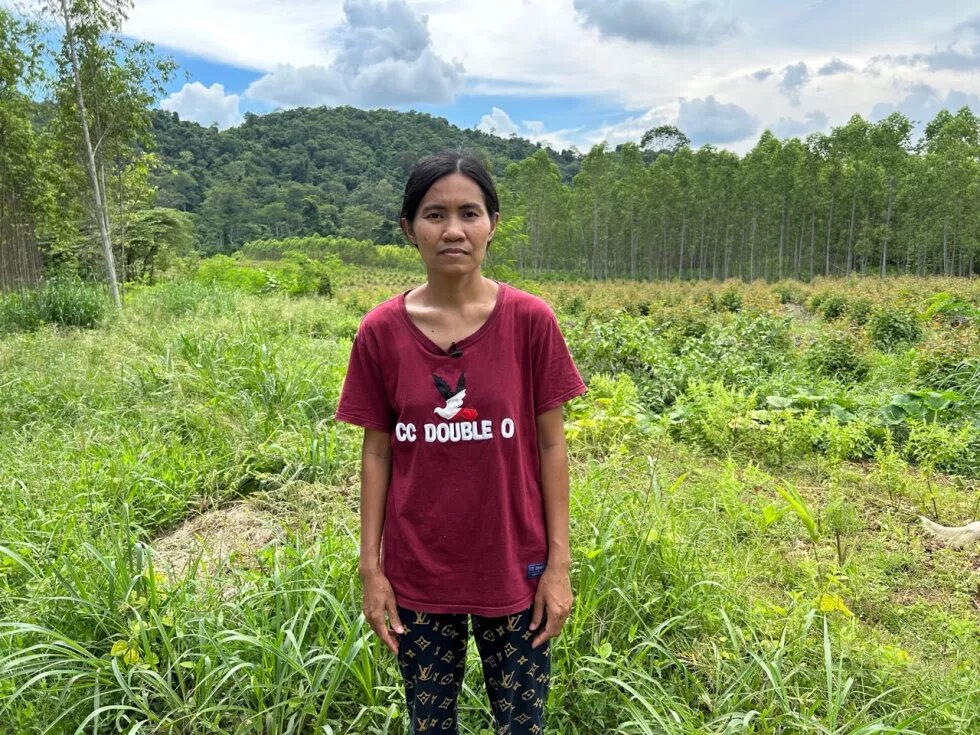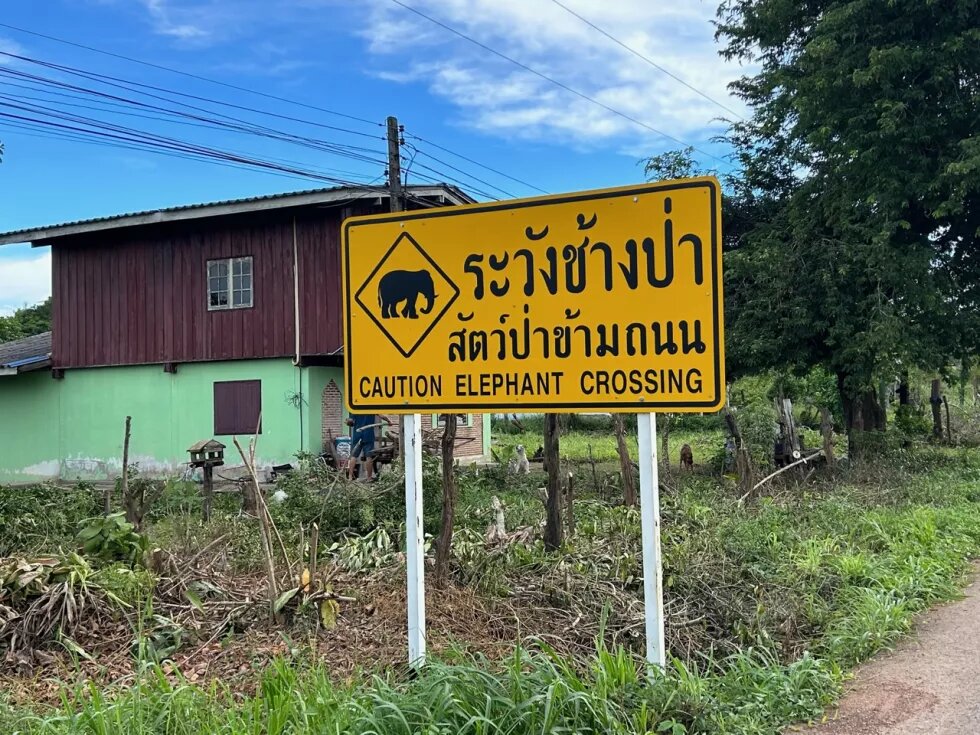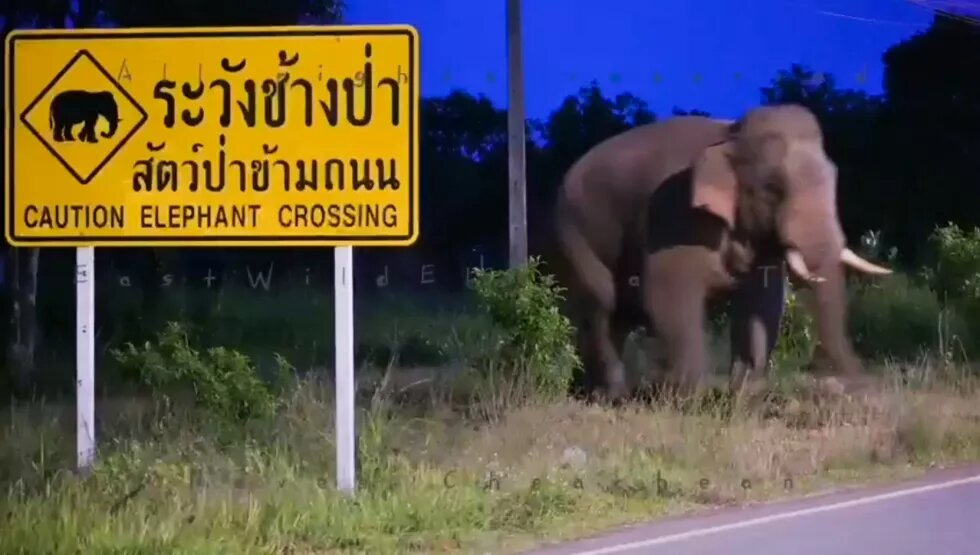
Just a two-hour drive from Bangkok, a war rages between humans and elephants. The animals are reclaiming areas that were once covered in jungle but are now agricultural lands. Villagers say they feel helpless as the elephants are raiding their communities, destroying entire harvests, and at times, killing farmers.

Piyawan Daonan, a farmer in the eastern province of Chachoengsao, grew worried when her husband did not return at his usual time from the cashew plantation behind their house on a late afternoon last year. She decided to go look for him. Halfway through the field, she found his clothes, torn off by a wild elephant that had trampled her husband to death and covered his body with soil.
Despite the sunlit green hills, soothing silence, and the sounds of birds around her home, they mask the deep trauma Piyawan is doomed to live with. She lives in constant fear, never knowing when the elephants might appear.
Piyawan’s son studies in Bangkok, but her nine-year-old daughter goes to the local school a few kilometers away. “I want to move away but that’s not possible. I have no money and no proof that I own my land," she says, tears welling up in her eyes.
That evening, a large male elephant is staring at her in the dark, right next to her wooden house. The nocturnal visitor indulged in the eucalyptus trees she recently planted, a crop that requires her to spend much less time in the field compared to the more profitable cashew nuts she grew before. Then, the animal finally leaves and disappears into the dark foliage across the road.
In the past six years, at least 150 people in Thailand were killed by wild elephants and more than 133 were injured. So far, at least 16 people lost their lives in encounters with wild elephants this year alone, according to Thailand’s Department of National Parks, Wildlife and Plant Conservation (DNP). Experts say the problems are most severe in five provinces east of Thailand, an area with many smallholder farmers that has the highest number of human casualties in the country.
Meanwhile, more than 92 elephants have been killed. In October, a woman in Surat Thani province faced charges of violating the Wildlife Conservation and Protection Act 2019 (B.E. 2562) after two wild elephants were electrocuted by wires she had placed around her durian orchard to protect her trees. If found guilty, she could be sentenced to a maximum of 10 years in prison and/or fined up to 1 million Thai baht. According to local media, the plantation is situated in a village in Kanchanadit district, within the boundaries of Tai Rom Yen National Park.
Throughout Thailand, humans have increasingly expanded into forest areas. According to the World Bank, forest cover in Thailand has declined from 53.5% in 1961 to 31.6% in 2014 as a result of agricultural expansion, population growth, infrastructure development, illegal logging and uncontrolled forest fires.
The focus has been on populating the eastern regions of the country and transforming them into agricultural land for exporting products, developing industries, and meeting the needs of a growing population. As a result, the traditional habitats of elephants became fragmented and their access to resources was often hindered.
The elephant, Thailand's national animal, has become an endangered species. Their numbers dwindled rapidly from 100,000 a century ago to between 3,000 and 3,500 today. The country realized it had to better protect its elephants, and created nature reserves for the animals to live safely.
In the past twenty years, due to successful conservation initiatives like intensified anti-poaching patrols, there has been a significant rise in the population of wild elephants in Thailand. At a birth rate of 8 percent, their number will continue to increase.
In search of more food and water, the elephants increasingly wander into farm communities where confrontations with humans can be fatal. Local villagers have teamed up with administrative and forestry officials of the DNP to patrol the nearby woods, locating elephants and drive them back into the forest.
Battle Against Crop-Raiding Elephants
“Pai, pai, paaaai!,” which means “go away, go away, go awaaay” in Thai, echoes loudly in a pitch-black pineapple field in Rayong province on a night in September. It is Nine in the evening and the atmosphere is tense. Using homemade fireworks and slingshots, farmers and government rangers try to chase away an elephant pillaging the field. It is dangerous work and farmers say it can make the elephants more aggressive. After nearly three hours, they finally manage to push the animal through a palm oil plantation back to the Khao Ang Rue Nai Wildlife Sanctuary.
“When the elephants come out of the forest, they are very dangerous to people,” says Panya, who leads several teams of volunteers. The farmers alert each other through a chat group whenever an elephant or herd is spotted. In the five provinces surrounding the forest reserve, farmers in numerous villages say they have to go out almost every evening to push back crop-raiding elephants.
Panya himself barely survived when he came face to face with an elephant in his backyard a couple of years ago. The animal broke his eye socket and nearly trampled him to death.
Recently, elephants have been spotted in new areas further away from the wildlife sanctuary, including the fields of Suphat, a former sugarcane farmer in Chonburi province. “I saw elephants here for the first time three years ago. First, it was two or three a day, now it’s fifteen of them. This year, they have
completely destroyed my harvest. So, I am switching to growing eucalyptus. Elephants don't like it as much as sugarcane. I will have to wait for the trees to grow, so this means I won’t have an income for the next three years.”
Villagers complain that the hotline to call rangers for help when they see an elephant works far too slowly. They also say that sometimes the rangers do not have money to buy gasoline. The most troublesome elephants wear GPS trackers, but these devices are expensive and according to researchers do not work fast enough as the signal comes through every four to six hours.
One of the government's popular measures is constructing fences. However, this strategy is expensive and deemed somewhat ineffective, as many elephants are intelligent enough to devise ways to escape, often causing damage to the barriers.
In 2020, the DNP launched a 10-year action plan to mitigate human-elephant conflict which aims to provide food and water resources, and a friendly environment for elephants living in protected forests, while creating a better understanding of elephants in nearby local communities. However, many challenges persist in areas where the number of elephants is higher than the amount of resources the forest can provide.
They also proposed hormone therapy or birth control. But this is a sensitive topic and needs more research. Another idea being considered is building corridors for the animals between the nature preserves, or relocating some elephants to other forest areas where there is still space for them.
“I’m afraid that relocation will merely move the problem from one place to another,” says Bhichet Noonto, a researcher and founder of the Human and Elephant Voices Network (HEVN). “We need a real-time early-warning system in every single community, more resources and data collection.”
At a workshop in Rayong last month, organized by HEVN and the Zoological Society of London (ZSL), the DNP, farmers, researchers, politicians of the opposition party, Move Forward and other stakeholders came together to discuss innovative wild elephant management tools, including compensation schemes, funding for people to adapt, nature-based solutions such as coffee agroforestry systems and protecting forests through carbon credits.
“We also talked about more cooperation between the DNP and subdistricts, so the DNP can use more funding outside the forests, and allocate of government budget to the subdistrict level. All parties agreed. We will continue our talks in December.”
The researcher says that farmers can claim financial compensation for crop damage if they are registered in the farmer’s database with the provincial agriculture department, including those without ownership of the land they use to grow their crops on. However, many say that the amount of compensation is not sufficient for around ten percent of damaged crops.
The government is currently in the process of setting up an insurance system involving four different ministries; although, many doubt if it will work if it ever materializes.
Climate Crisis Exacerbates Elephant Strife
“Climate change will have an impact on natural resources, particularly on water availability, as new reservoirs and dams have been built in the east. So besides insufficient food sources, there will also be less water for elephants,” says Chutiphong Pipoppinyo, Member of Parliament of the Move Forward party.
Born and raised in Rayong, a province often called the fruit basket of Thailand, the first-time MP is very familiar with the issues between local people and elephants. In September, he launched a new parliamentary committee to help address the problems.
“It’s tragic that so many people have lost their lives,” Chutiphong says in an interview at Parliament House in Bangkok. “Elephants can also cause thousands of dollars in damage in just a single day, but we need to collect more data on crop-raiding patterns and loss of income to effectively deal with the problem.”
On the same day, a network of people affected by threats from wild elephants filed a complaint at the House of Representatives, saying that the conflict between local people and wild elephants has escalated. The network, led by Secretary-general Suwichan Suwannakha, is urging the House to legislate a law to address the problem. “They also want the government to build a barrier to prevent the elephants from coming out of the wildlife preserve,” says Chutiphong Pipoppinyo. “I’m afraid it would become one big elephant prison. How would we be able to manage the elephants inside?”
Dr Somnuck Jongmeewasin, research director of EEC Watch, warns that the competition for resources between humans and elephants will intensify as the Eastern Economic Corridor (EEC) expands further. Between 2017 and 2037, Thailand is planning to build 60 percent industrial development and 33 percent so-called ‘smart city’-projects in the area.
“They are currently building more water reserves. As land in the EEC is expensive, this is done outside the special economic zone. Right now, there are three dams under construction in Chantaburi province and a fourth one is underway. Elephants are hanging around these water reserves and this causes problems for the people in those areas. The industry could actually do with a 40 percent water reduction, if they used the right technology,” says Dr Somnuck.
The construction of dams also reduces forest area. “The fourth dam hasn’t been built yet as it will encroach on a protected forest area, Khao Siphachan.”
Rural residents say people in Bangkok and some conservationists do not understand, or ignore, the seriousness of the conflict situation. “They adore wild elephants and think the farmers are to blame. Elephants are our national pride and nobody should touch them, is the general attitude,” says MP Chutiphong Pipoppinyo. As an example, he mentions how a video of a wild elephant stealing food from a house was recently presented by a Thai media channel as something ‘cute’.
“The government tells us that people must learn to live with the elephants,” says farmer Piyawan. “Here, in the countryside, we see that this is nonsense. I have lost my husband. The only solution to this problem is to drive all elephants out of this area.”
__
Annelie Langerak is a Journalist and Correspondent director for publicity of the Foreign Correspondents' Club of Thailand (FCCT)
The views expressed in this article are not necessarily those of Heinrich Böll Stiftung.



